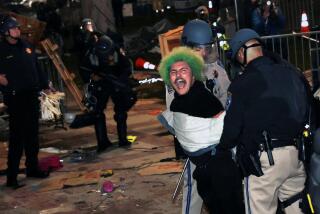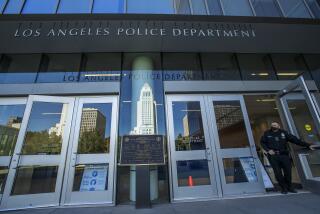Gunfight Fuels Debate Over Police Weapons
The military-style firefight that raged on the streets of Los Angeles on Friday has ratcheted up the debate over whether it is time to arm police with more powerful weapons to close the gap with increasingly well-armed crooks.
Just such a proposal, put forward by rank-and-file police, has reportedly been stalled on Chief Willie L. Williams’ desk for months, to the frustration of the Police Protective League and others. But even though advocates of the switch from 9-millimeter weapons to the more powerful .45-caliber pistols vowed to use Friday’s violence to advance their cause, other experts warned against a headlong arms race.
Many say the problem is that bad guys don’t care who they hit, but police must care. “If you put ARs [semiautomatic rifles] in everybody’s vehicle, we’re going to have more mishaps than positive results” without extensive training, warned Los Angeles Police Department SWAT Sgt. Charles Duke. “Are we going to overreact because of one incident?”
Nevertheless, the televised images of cops in shirt-sleeves retreating from men spraying what one police source described as armor-piercing bullets from AK-47 automatic rifles--military submachine guns--will live long in the minds of Los Angeles residents accustomed to film and TV violence. Friday’s robbery at a North Hollywood bank left two suspects dead and 11 police officers injured or wounded.
“The issue of the .45 was resolved with yesterday’s incident. If any good came out of this, it will be giving the officers the ability to carry .45s,” said Dennis Zine, director of the Police Protective League.
Some firearms experts said, however, that the criminals in Friday’s robbery were so heavily armed that more powerful handguns would not have made an appreciable difference.
Police observers said the brazen way the robbers acted was an indication that they knew they carried more powerful weapons than the police who first arrived on the scene.
“We are not playing on an even playing field,” said former Los Angeles Police Chief Tom Reddin. “We should find some way to upgrade the capability of field officers in dealing with situations where they confront automatic weapons.”
LAPD Cmdr. Tim McBride said that “this violent trend is an escalating trend that we have been experiencing . . . where we have many suspects who have multiple guns and they continue to outgun us and fire at us at will.”
Indeed, there were disturbing similarities to other violent clashes throughout the country between police and heavily armed criminals.
Law enforcement sources recalled the bloodiest day in FBI history, a 1986 shootout outside a South Florida bank that left two FBI agents dead and five wounded. Suspects carrying a Colt AR-15 assault rifle and a Ruger Mini-14 semiautomatic rifle squared off with agents carrying standard-issue handguns.
In 1994, a father-and-son team robbed a Wisconsin bank. Chased by Waukesha police Capt. James Lutz, 57, the gunmen pulled over, got out of their car and calmly advanced on Lutz, firing assault weapons that killed him. As was the case with the North Hollywood robbers, both men were shielded by body armor.
“Local law enforcement has been outgunned for years and years,” said Morton Feldman, executive vice president of the National Assn. of Chiefs of Police. That doesn’t mean police, much as they might want them, should be issued automatic rifles to match the weaponry of their enemies, he said.
Nonetheless, some officers on the front lines say the gap between them and lawbreakers is widening dangerously. The LAPD now issues its patrol officers 9-millimeter semiautomatic handguns--Army-style Berettas--a change from the .38 special revolvers they carried for generations. The change to the 15-shot 9-millimeters came in 1986 precisely because officers complained that they were outgunned when they faced off with slow-firing six-shooters against criminals armed with semiautomatics, shooting more shots faster.
Each patrol car is also equipped with a 12-gauge Ithaca shotgun, which carries four rounds of heavy buckshot.
All field officers are issued Kevlar vests to shield them from bullets. However, even the thickest vest will not stop the kind of ammunition leveled at police during Friday’s incident.
SWAT officers are the only ones in the LAPD allowed to use heavier weaponry. “We have a whole host of specialty weapons,” said Duke, the SWAT sergeant. He said his officers may carry MP-5 rifles, a scoped rifle and semiautomatic AR-16 rifles. He refused to discuss whether they have access to machine guns.
While Duke said it would be nice to provide patrol cops with a better arsenal, he worried about a minority who would not train as diligently as SWAT officers do.
However, some officers say the LAPD has not kept up with other departments in arming its officers. Spokesmen for the Police Protective League said the LAPD’s own study shows that 72% of surveyed California police agencies allow their officers to carry the .45-caliber pistol as their primary duty weapon.
Even much smaller suburban departments are equipping their officers with more sophisticated weaponry.
Sgt. Jeffrey Powell of the Alhambra police said all his department’s patrol officers carry shotguns and MP-5 carbines in their cars, which were obtained “after a couple of incidents involving officers facing people with rifles and more powerful weapons.” The advantage, he said, is that the MP-5 has a longer range and is more accurate than a shotgun.
Dave Hepburn, spokesman for the Police Protective League, said Friday’s incident adds urgency to the debate.
“The first thing Monday morning,” he said, “I’ll be calling [Williams’] office and saying, ‘Are we going to take care of this?’ ”
One source who asked not to be identified said there is significant opposition to the proposal in the upper echelon of the department.
“The chief is sitting on a proposal that will improve the safety of our officers,” said Police Protective League board President Bill Harkness in a letter to City Councilwoman Laura Chick. He wrote that one LAPD study revealed “numerous incidents” in which suspects wounded by officers with 9-millimeter weapons were able to continue their attacks.
Chick, chairwoman of the council’s Public Safety Committee, wrote the Board of Police Commissioners on Dec. 5, 1996, saying she was “interested in having the [commission] address the issue of having the Los Angeles Police Department undertake a test program for the .45-caliber pistols.”
The .45-caliber weapon is generally believed to have more stopping power. But Ed Nowicki, a former director of the American Society of Law Enforcement Trainers, said the problem with the .45 is its larger grip, which could be awkward for smaller officers.
Ken Ferber, a spokesman for the Board of Police Commissioners, said the board met with Williams on Feb. 4 in closed session and asked him for a formal response. Ferber said Williams agreed to respond, but has not yet done so.
One high-ranking LAPD officer said Williams “was waiting to be directed” by the Police Commission to begin a pilot program for the use of the weapons. “Then, if things fell apart, he could say he was told to do it.”
Williams, meanwhile, seemed to urge restraint at a news conference Saturday, saying, “You can’t equip our general patrol officer with an AK-47. We’re supposed to live in somewhat of a civilized society.”
But he tacitly admitted that the LAPD has fallen behind.
“When we switched to the 9-millimeter, we were ahead of the curve, and we will have to catch up again.”
In reality, though, .45s would not have evened the playing field Friday.
“A police officer’s effectiveness with a handgun is 50 to 75 feet,” said Sgt. Dean Caputo, in charge of firearms training for Arcadia police. “With a rifle, it extends to 75 yards.”
In long-range gun battles “you want to be able to deliver lethal force at long distance,” he said. “A person armed with a rifle dominates his environment almost as far as he can see.”
Reddin, the former police chief, suggested that rather than equipping every patrol car with a high-powered rifle, each police division could be outfitted with more sophisticated weaponry, on which a select number of officers would be rigorously trained.
One thing that seems certain is that there will be more gun battles like the one Friday, sources said. Caputo said 20 million to 40 million AK-47s have been manufactured.
More to Read
Sign up for Essential California
The most important California stories and recommendations in your inbox every morning.
You may occasionally receive promotional content from the Los Angeles Times.










